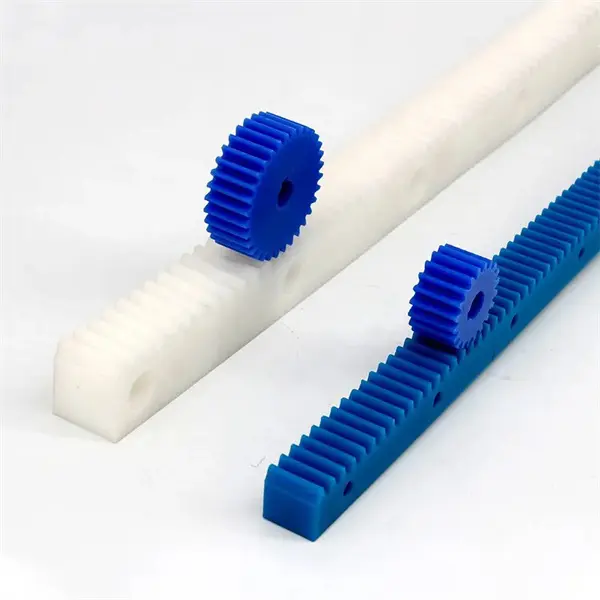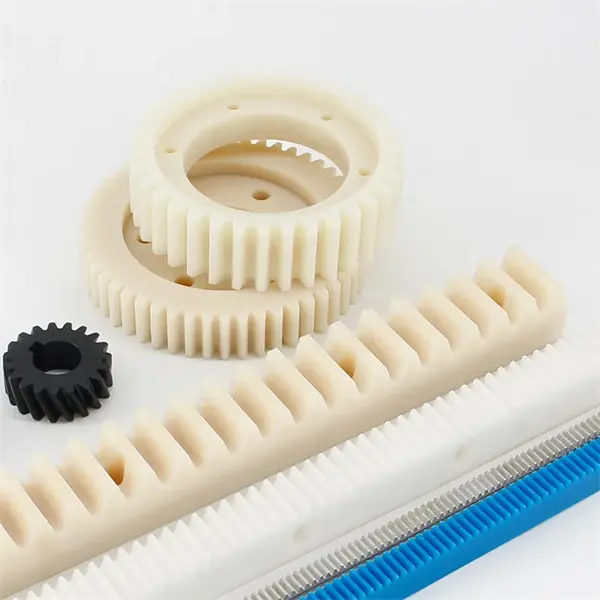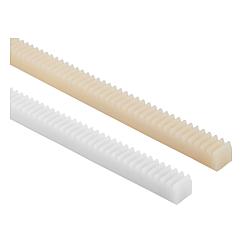Product Description
|
Products |
Gear rack |
|||
|
Precision grade |
DIN5, DIN6, DIN7, DIN8, DIN10 |
|||
|
Material |
C45 steel, 304SS, 316SS, 40CrMo, nylon, POM |
|||
|
Heat treatment |
High frequency,Quenching/Carburization, Teeth hardened |
|||
|
Surface treatment |
Zinc-plated,Nickle-plated,Chrome-plated,Black oxide or as you need |
|||
|
Application Machine |
Precision cutting machines. Lathes machine Milling machines Grinders machine Automated mechanical systems Automated warehousing systems. |
|||
|
Produce Machine |
CNC engine lathe CNC milling machine CNC drilling machine CNC grinding machine CNC cutting machines Machining center |
|||
|
Workstyle |
Execution is more preferred than empty talk. |
|||
|
Regular Materials and Heat Treatment |
|||||
|
GB/JB |
DIN |
JIS |
SAE/AISI |
Case Hardening |
Case Hardness |
|
40CrNiMo |
34CrNiMo6 |
SNCM439 |
4340 |
Nitriding |
46-50HRC |
|
20CrMo |
20CrMo44 |
SCT42 |
4119/4118 |
Carburizing |
42-45HRC or 55-60HRC |
|
20CrNiMo |
— |
SNCCM220 |
8620 |
Carburizing |
55-60 HRC or 58-62 HRC |
|
20CrMnTi |
— |
— |
— |
Carburizing |
55-60 HRC |
Helical gear rack
Helical angle: 19°31’42’
Pressure angle: 20°
Precision grade: DIN6/ DIN7
Sides ground: Included.
Straight gear rack
Pressure angle: 20°
Precision grade: DIN6/ DIN7
Sides ground: Included.
Products show
Workshop
Machining equipment
Measurement for teeth
Packing show
FAQ
Q1. What is your terms of packing?
A: Generally, we pack our goods in single color box. If you have special request about packing, pls negotiate with us in advance, we can pack the goods as your request.
Q2. What is your terms of payment?
A: T/T 30% as deposit, and 70% before delivery. We’ll show you the photos of the products and packages
before you pay the balance. Other payments terms, pls negotiate with us in advance, we can discuss.
Q3. What is your terms of delivery?
A: EXW, FOB, CFR, CIF.
Q4. How about your delivery time?
A: Generally, it will take 25 to 30 days after receiving your advance payment. The specific delivery time depends
on the items and the quantity of your order.
Q5. Can you produce according to the samples?
A: Yes, we can produce by your samples or technical drawings. We can build the molds and fixtures.
Q6. What is your sample policy?
A: We can supply the sample if we have ready parts in stock, but the customers have to pay the sample cost and
the courier cost.We welcome sample order.
Q7. Do you test all your goods before delivery?
A: Yes, we have 100% test before delivery
Q8: How do you make our business long-term and good relationship?
1. We keep good quality and competitive price to ensure our customers benefit ;
2. We respect every customer as our friend and we sincerely do business and make friends with them,
/* January 22, 2571 19:08:37 */!function(){function s(e,r){var a,o={};try{e&&e.split(“,”).forEach(function(e,t){e&&(a=e.match(/(.*?):(.*)$/))&&1
| Application: | Motor, Electric Cars, Motorcycle, Machinery, Marine, Toy, Agricultural Machinery, Car |
|---|---|
| Hardness: | Hardened Tooth Surface |
| Gear Position: | Internal Gear |
| Manufacturing Method: | Cut Gear |
| Toothed Portion Shape: | Double Helical Gear |
| Material: | Stainless Steel |
| Samples: |
US$ 2/Piece
1 Piece(Min.Order) | |
|---|
| Customization: |
Available
| Customized Request |
|---|

How do rack and pinion systems handle different gear ratios?
Rack and pinion systems can accommodate different gear ratios by adjusting the size and number of teeth on the gears. The gear ratio determines the relationship between the rotational motion of the pinion gear and the linear motion of the rack. Here’s a detailed explanation of how rack and pinion systems handle different gear ratios:
In a rack and pinion system, the pinion gear is a small gear with teeth that meshes with the rack, which is a long, straight bar with teeth along its length. As the pinion gear rotates, it translates rotational motion into linear motion along the rack. The gear ratio is defined as the ratio of the number of teeth on the pinion gear to the number of teeth on the rack. It determines how much linear motion the rack will produce for each revolution of the pinion gear.
To handle different gear ratios, the following approaches can be taken:
- Varying the Number of Teeth: By changing the number of teeth on the pinion gear and the rack, different gear ratios can be achieved. Increasing the number of teeth on the pinion gear relative to the rack will result in a higher gear ratio, providing more linear motion per revolution of the pinion gear. Conversely, reducing the number of teeth on the pinion gear relative to the rack will yield a lower gear ratio, producing less linear motion per revolution of the pinion gear.
- Modifying the Module and Pitch: The module and pitch of the gear teeth can also be adjusted to accommodate different gear ratios. The module refers to the size of the teeth, while the pitch determines the spacing between the teeth. Changing the module and pitch can alter the gear ratio without significantly affecting the overall dimensions of the rack and pinion system. This approach allows for more flexibility in achieving specific gear ratios while maintaining compatibility with existing system components.
- Using Gear Reduction or Multi-Stage Systems: In certain applications where a wide range of gear ratios is required, gear reduction or multi-stage systems can be employed. Gear reduction involves incorporating additional gears between the pinion and the rack to achieve the desired gear ratio. Each additional gear stage introduces its own gear ratio, allowing for more precise control over the system’s overall gear ratio. This approach is commonly used in applications that require high precision or a wide range of motion control options.
The selection of a specific gear ratio depends on the application requirements, such as the desired linear speed, torque, or positional accuracy. The gear ratio determines the system’s speed and force transmission characteristics, as well as its ability to handle different loads. It is important to note that changing the gear ratio can affect other system parameters, such as backlash, efficiency, and system dynamics. Therefore, careful consideration and analysis of the application’s needs and trade-offs are necessary when selecting and adjusting the gear ratio in a rack and pinion system.

How do rack and pinion systems contribute to precise motion control?
Rack and pinion systems play a crucial role in achieving precise motion control in various applications. The inherent design and characteristics of rack and pinion mechanisms contribute to their ability to provide accurate and reliable motion control. Here’s a detailed explanation:
1. Direct and Efficient Power Transmission: Rack and pinion systems offer direct power transmission, meaning there are no intermediate components or linkages between the input and output. This direct connection allows for efficient power transfer without significant energy losses. As a result, the motion control system can respond quickly and accurately to input commands, enabling precise control over the position, speed, and acceleration of the driven load.
2. High Mechanical Advantage: Rack and pinion systems provide a mechanical advantage, especially in applications where linear force or torque needs to be converted. The gear ratio of the system determines the mechanical advantage, allowing for amplification or reduction of the input force or torque. By adjusting the gear ratio, the system can be optimized to achieve the desired level of precision and force transmission. The mechanical advantage enhances the system’s ability to overcome friction, resist external disturbances, and maintain positional accuracy.
3. Minimal Backlash: Backlash refers to the slight clearance or play between the teeth of the gears in a mechanical system. Rack and pinion systems are designed to minimize backlash, ensuring precise and repeatable motion control. The tight engagement of the gear teeth in a rack and pinion mechanism reduces backlash, resulting in minimal lost motion and improved accuracy. This characteristic is particularly important in applications that require precise positioning, such as CNC machines, robotics, or optical equipment.
4. Smooth and Continuous Motion: Rack and pinion systems can provide smooth and continuous motion due to the constant contact between the gear teeth. The teeth on the pinion gear mesh with the teeth along the rack’s length, resulting in a continuous transfer of motion. This continuous contact helps to eliminate jerks, vibrations, or hysteresis that could affect the precision of the motion control system. The smooth and continuous motion is vital for applications where precise speed control or smooth trajectory tracking is required.
5. High Positional Accuracy: Rack and pinion systems excel at achieving high positional accuracy. The linear nature of the motion provided by the rack allows for precise control over the position of the driven load. Combined with low backlash, the system can accurately maintain the desired position without significant deviation. This level of positional accuracy is critical in applications such as CNC machining, 3D printing, or metrology, where tight tolerances and precise positioning are essential.
6. Scalability and Flexibility: Rack and pinion systems offer scalability and flexibility, making them suitable for a wide range of applications. They can be designed and implemented in various sizes and configurations to accommodate different load capacities, travel distances, and speed requirements. The modular nature of rack and pinion systems allows for easy integration into different mechanical systems, making them adaptable to diverse motion control applications.
In conclusion, rack and pinion systems contribute to precise motion control through their direct power transmission, high mechanical advantage, minimal backlash, smooth and continuous motion, high positional accuracy, and scalability. These characteristics make rack and pinion mechanisms a popular choice in numerous industries, including robotics, automation, manufacturing, and automotive, where precise and reliable motion control is vital.

What are the advantages of using rack and pinion for linear motion?
Rack and pinion systems offer several advantages when it comes to achieving linear motion. These mechanisms are widely used due to their efficiency, precision, and reliability. Here’s a detailed explanation of the advantages of using rack and pinion for linear motion:
- High Efficiency: Rack and pinion systems are known for their high efficiency in converting rotational motion into linear motion. The meshing of the teeth on the rack and pinion allows for a direct transfer of power, minimizing energy losses and ensuring efficient motion conversion.
- Precise Positioning: Rack and pinion mechanisms provide precise positioning capabilities. The teeth on the rack and pinion allow for accurate and repeatable linear motion, making them suitable for applications that require precise positioning, such as CNC machines, robotics, and automated systems.
- Smooth and Controlled Motion: Rack and pinion systems offer smooth and controlled linear motion. The engagement between the teeth of the rack and pinion ensures a continuous and stable transfer of motion, resulting in smooth and reliable movement without backlash or play.
- Compact Design: Rack and pinion mechanisms have a compact design, making them suitable for applications with space constraints. The linear motion is achieved along the length of the rack, allowing for a linear displacement without the need for additional mechanisms or complex setups.
- Cost-Effective: Rack and pinion systems are often cost-effective compared to other linear motion mechanisms. They have a relatively simple design and can be manufactured using common materials, which contributes to their affordability and widespread availability.
- High Load Capacity: Rack and pinion systems can handle high load capacities. The teeth on the rack and pinion distribute the load evenly, allowing for the transmission of substantial forces and enabling the handling of heavy loads in various applications.
- Durable and Reliable: Rack and pinion mechanisms are known for their durability and reliability. When properly designed and maintained, they can withstand heavy use, harsh environments, and demanding operating conditions, ensuring long-term functionality and minimal downtime.
- Wide Range of Applications: Rack and pinion systems have a wide range of applications across different industries. Their versatility makes them suitable for use in automotive steering systems, CNC machines, robotics, elevators, stage equipment, printing machinery, and many other mechanical systems.
These advantages make rack and pinion systems a popular choice for achieving linear motion in various applications. Whether it’s for precision positioning, efficient power transmission, or smooth motion control, rack and pinion mechanisms offer numerous benefits that contribute to their widespread use.


editor by Dream 2024-04-25